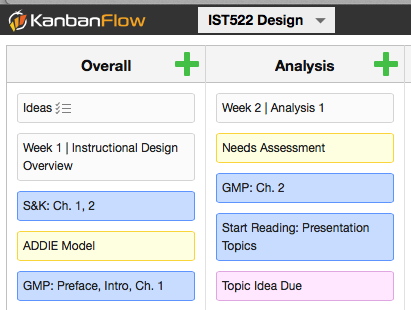Let’s say you have a 16-week (or 16-hour) course to plan, and it has a lot of moving pieces: topics, objectives, resources, readings, activities, quizzes, individual and group assignments, etc. And let’s say that you want a flexible way to map it all out as you are figuring out what to do and when.
About 30 years ago, Dr. Jerry Kemp suggested using 3 x 5 cards and a planning board to work out ideas for structuring courses. Creating a wall of sticky notes is another way to do this. Both of these methods are useful, if a bit cumbersome (and difficult to keep around for revising your course later).
To create an electronic equivalent, I used KanbanFlow (KBF) as an updated way to organize my design elements for a 16-week course on instructional design. Here’s one little corner of the planning board I used.

You can move the “cards” (called “tasks” in KBF) around the board until you have everything orchestrated in a way that makes sense. At that point, you can write up your weekly schedule, and you’re ready to share with your learners. (This does not take the place of front-end analysis or writing objectives, which you would usually do first.)
Here are a few ways to make this easier.
- Use columns for different sections of the course: Overview, Topic 1, Topic 2, etc.
- Pick colors for your cards that make sense to you for topics, readings, assignments, etc. In the example pictured above, readings are blue.
- Use different colors for individual and group assignments (if you have both), so you can easily see where they fall in your design.
- Add cards for timing: for example:
- Week 1, Week 2….
- Day 1 A.M., Day 1 P.M….
- Module 1, Module 2….
- Put each major topic on a card. Group them with the hours or weeks, paying attention to sequence and timing.
- Add cards for readings, presentations, practice sessions, assignments, and quizzes, as applicable.
- You can add more detail to any card, via Descriptions or Subtasks. You can also add files from your hard drive, Dropbox, or Google Drive.
- As you review the finished product, make adjustments for timing, instructional support, and workload.
- Adjust as necessary.
The board itself is just for you (and your team, if applicable). It’s more linear than a mind map but still so flexible. For courses with multiple moving parts, it’s a helpful step to take before committing to your final plan.
Using KBF can save a lot of time and gnashing of teeth (for complicated designs). The color-coded overview makes it easy to be sure that you are providing the right elements at the right time to support learning.
Resources
Resource | KanbanFlow
Article | The Kemp Model of Instructional Design
Post | 4 Easy Steps to Organize Your Thoughts
Post | Getting More Done with KanbanFlow
Post | KanbanFlow Right Through Your [Productive] Day
Post | Keeping Resolutions–Goals–Habits Visible with KanbanFlow
